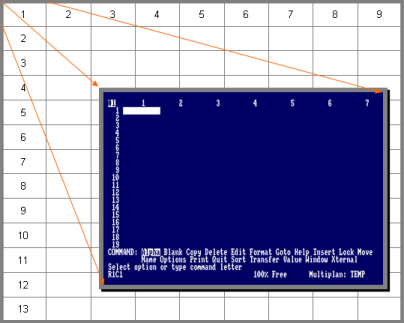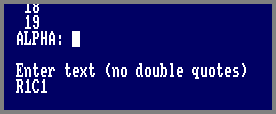MULTIPLAN is a spreadsheet application by Microsoft. It was called at former times (1983) one of the most powerful and user-friendly "electronic worksheets" and together with VisiCalc (from Software Arts), a typical CP/M application of its time (late seventies / early eighties).
HARDWARE REQUIREMENTS
The application runs under CP/M with at least one floppy disk drive and a memory of 128 kByte, better with at least 62 Kbytes TPA (free space available under a patched CP/M2.2 or - of course - plus / 3), and a monitor 80 characters per line (which is included by the purchased standard monitors GT & GTM - they managed this resolution by default). Multiplan runs on all CPCs of the old (and new) generation, provided the computers 464 and 664 had a memory expansion (eg. VORTEX, or other, similar additional hardware). A printer could be accessed via the Centronics interface. The operation of a second floppy drive was recommended in terms of a more comfortable work. All files of the original Multiplan version being used on the usual 170 kByte 135 kByte floppy (without operating system).
a MULTIPLAN description in short
THE SCREEN LAYOUT
In the same way like his successor, Windows-Excel, it can be entered directly in the fields with text, values or formulas. The field itself can be selected via a row-column coordinate system. The formats of the columns can be changed in a very limited basis (due to text-only presentation). Cells can be assigned names. Areas can be protected against overwriting. The application provides menus for selecting functions or assistance (eg, sorting, iteration, mathematical, numerical, logical functions such as SIN, COS, LN, LOG, MAX, MIN, STDEV, AND, OR, IF / THEN, etc.). Data exchange with other programs (eg, the former WordStar) was possible.
On the top level of the screen (about 80 percent) you will see the table with its row and column indicators. The maximum by default is 7 columns and 19 rows. The first area is highlighted. Changing the area could be done by pressing the cursor keys.
There are two command lines underneath which could be highlighted by the Tab key and activated with Enter key.
The next two lins show the command status and underneath on the left side the actual highlighted area, in the middle free space and on the right side the name of the file.
TABLE LAYOUT AND COMMANDS
VALUES could be a number between 0-9, ",", "=", "+", "-", "(", ")" oder double quotes itself.
To insert a number, figure or a formula press TAB until you reach "VALUE" or press its initial. Normally you put in a number between 0-9. Nothing else, but a formula.
For changing a cell / row / coloumn format you will enter the "FORMAT" command. Their options are "Cells, Default, Options, Width". With "Cells" you're able to define a single cells appearance (alignment or format-code). Alignment could be: Default, Center, Block, Left or Right. Format-code could be: Default, Continous, Exponential, Fix Comma Number, Block, Integer, Currency, Chart, Percent, no changes.
To define or operate over a range of cells it is necessary to use a COLON between two cell-item-specification (e.g. R1C1:R1C6 = is a range of six cells among each other)
With the command "INSERT" or "DELETE" you are able to insert or delete a certain number of rows or coloumns before or after the highlighted cell.
Sources
- Schneider CPC: Erfolg mit MULTIPLAN by Thorsten Ritter, Publisher: Sybex, 1986
- MULTIPLAN für den Schneider CPC by Dr. Peter Albrecht, Publisher: Markt & Technik, 1985
- MICROSOFT MULTIPLAN for the Schneider CPC 464 - 3 inch Disk Format, Original User Manual, Publisher: Markt & Technik, 1985

